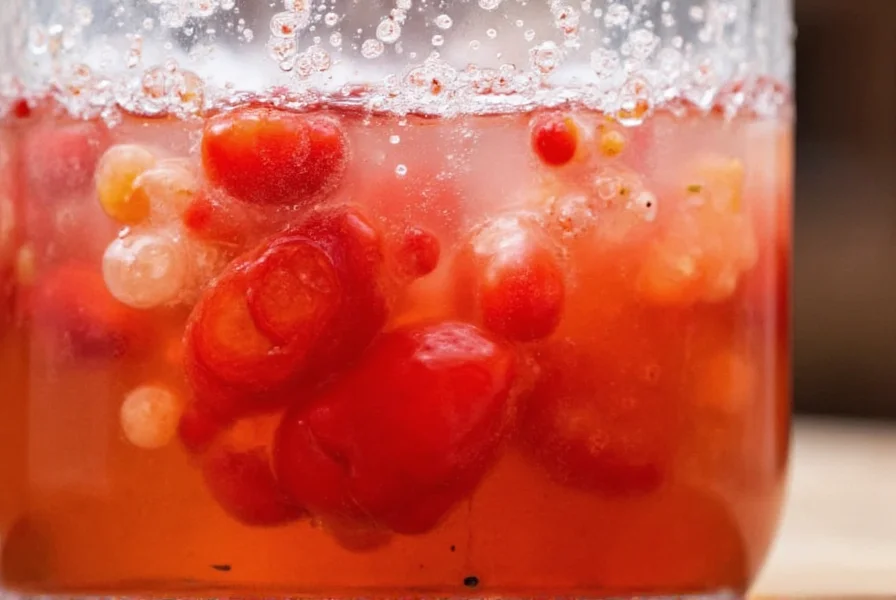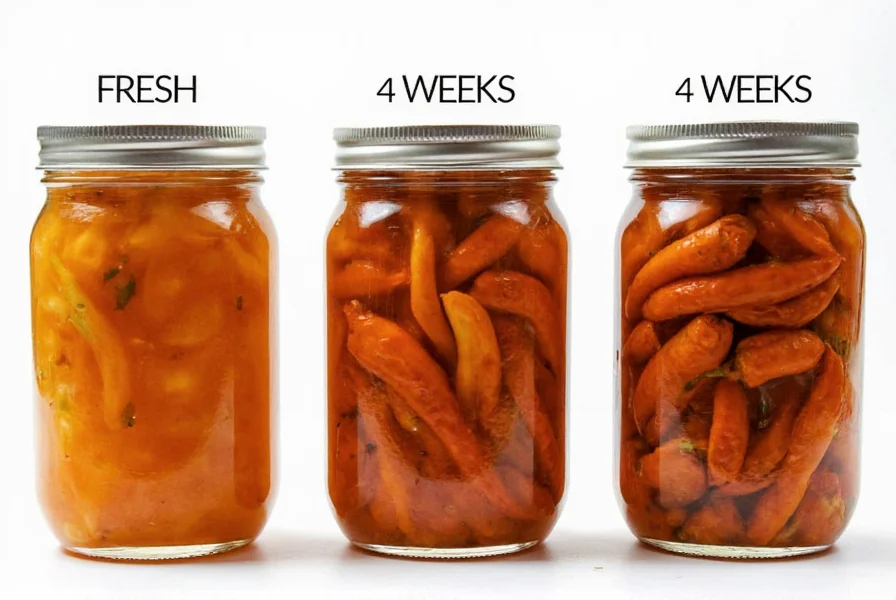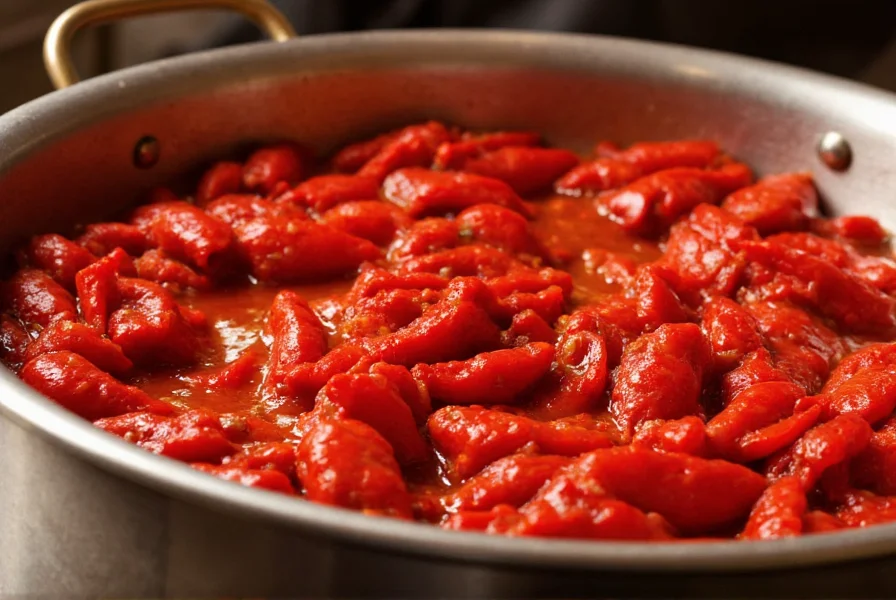Fermentation unlocks a world of flavor complexity that simple pickling cannot achieve. Unlike vinegar-based preservation which merely infuses acidity, lactic acid fermentation creates a dynamic biochemical process where Leuconostoc and Lactobacillus bacteria naturally present on chili skins convert sugars into lactic acid, carbon dioxide, and aromatic compounds. This biological transformation develops nuanced flavors ranging from bright citrus notes in early fermentation to deep, savory umami in extended ferments.
The Biochemistry of Chili Fermentation
Chili fermentation follows the same principles as other vegetable ferments but with unique considerations for the capsaicin-rich peppers. The process begins when salt draws moisture from the chilies, creating an anaerobic environment that favors lactic acid bacteria while inhibiting harmful microorganisms. During the first 3-5 days, Leuconostoc mesenteroides dominates, producing carbon dioxide that creates bubbling activity and initial flavor development. As acidity increases, Lactobacillus plantarum takes over, continuing the fermentation process for weeks or months.
Key chemical changes include:
| Stage | Primary Bacteria | Flavor Compounds Produced | pH Range |
|---|---|---|---|
| Days 1-5 | Leuconostoc species | Diacetyl (buttery notes), acetic acid | 4.2-3.8 |
| Weeks 2-4 | Lactobacillus plantarum | Lactic acid, esters (fruity notes) | 3.8-3.5 |
| Month 2+ | Lactobacillus brevis | Complex umami compounds | 3.5-3.2 |
Optimal Equipment and Ingredients
Successful chili fermentation requires minimal but specific equipment. Glass jars with airlock systems prevent oxygen exposure while allowing CO2 release, eliminating the need for daily burping. Ceramic crocks with water moats work well for larger batches. Avoid metal containers as acidity can cause corrosion. For small batches (1-2 lbs of chilies), 1-quart mason jars with fermentation-specific lids provide excellent results.
When selecting chilies, consider both heat level and sugar content. Thin-walled varieties like jalapeños and serranos ferment faster than thick-walled habaneros. Red chilies generally contain more sugars than green, yielding more complex flavor development. Always use non-iodized salt—sea salt or pickling salt at 2-3% concentration (20-30g per kg of water). Iodine inhibits bacterial growth, while anti-caking agents may cloud the brine.

Step-by-Step Fermentation Process
Begin by thoroughly washing 1 pound of fresh chilies and removing stems. For milder flavor, remove seeds and membranes; for maximum heat retention, keep them intact. Chop chilies to your preferred consistency—fine dice for hot sauces, larger chunks for relishes. Combine with 1 tablespoon of non-iodized salt and massage vigorously for 5 minutes until liquid releases.
Pack the chilies tightly into your fermentation vessel, pressing down to eliminate air pockets. Prepare a 3% brine (1.5 oz salt per quart of filtered water) and pour over chilies until fully submerged, leaving 1-2 inches of headspace. Place a fermentation weight to keep chilies below the brine line. Seal with an airlock system and store at 68-72°F (20-22°C) away from direct sunlight.
Monitor daily for the first week for signs of active fermentation: bubbling, cloudiness, and a pleasantly sour aroma. Skim any surface mold that may form (typically harmless kahm yeast). After 7 days, taste regularly to determine preferred flavor development. Most chilies reach optimal flavor between 14-28 days, though extended ferments (2-6 months) develop deeper complexity.
Flavor Development Timeline
Understanding the flavor evolution during fermentation helps achieve your desired results:
- Days 1-3: Initial enzymatic breakdown begins; flavors remain predominantly fresh chili with slight tang
- Days 4-7: Active fermentation develops bright acidity and subtle complexity; ideal for fresh-tasting hot sauces
- Weeks 2-3: Peak flavor development with balanced acidity, umami, and preserved chili character; perfect for most applications
- Month 1-2: Deep, complex flavors emerge with mellowed heat; excellent for gourmet hot sauces and condiments
- 2+ Months: Intense umami and subtle funk develop; best for specialty applications requiring deep flavor complexity

Safety Considerations and Troubleshooting
Properly fermented chilies should smell pleasantly sour, never putrid or rotten. A white film (kahm yeast) on the surface is generally harmless and can be skimmed off. Discard any batch showing pink, black, or blue mold, or emitting foul odors. The brine should remain cloudy throughout fermentation—clear brine indicates potential fermentation failure.
Common issues and solutions:
- Mold formation: Usually caused by oxygen exposure; ensure chilies remain submerged and use proper airlock system
- No bubbling: May indicate insufficient salt or temperature too low; check salt concentration and move to warmer location
- Soft or mushy chilies: Often from over-fermentation or excessive heat; reduce fermentation time or temperature
- Excessive saltiness: Rinse fermented chilies before use or adjust salt ratio in future batches
Culinary Applications of Fermented Chilies
Fermented chilies shine in applications where complex acidity enhances the dish. Blend with vinegar and spices for hot sauces that develop richer flavor over time compared to fresh-chili sauces. Finely chopped fermented jalapeños add depth to salsas and guacamole. For cooking, add fermented chilies during the final stages to preserve live cultures and delicate flavors. The brine itself makes an excellent addition to salad dressings, marinades, or even cocktails for a probiotic kick.
Professional chefs increasingly use long-fermented chilies (2+ months) as flavor enhancers in dishes where subtle heat and umami are desired without overwhelming spice. The fermentation process breaks down capsaicinoids into more complex compounds, creating a different heat profile that feels more integrated with the food rather than simply hot.
Frequently Asked Questions
How long does chili fermentation typically take before it's ready to eat?
Most chili ferments reach optimal flavor between 14-28 days at room temperature (68-72°F). You can begin tasting after 7 days to determine your preferred flavor development. Shorter ferments (7-14 days) retain more fresh chili character with bright acidity, while longer ferments (3-6 weeks) develop deeper umami notes. The fermentation continues slowly even under refrigeration, so flavors will continue evolving over months.
Can I ferment different types of chilies together in the same batch?
Yes, combining different chili varieties creates complex flavor profiles, but consider their sugar content and wall thickness. Thin-walled chilies like jalapeños ferment faster than thick-walled varieties like habaneros. For best results, chop all chilies to similar sizes and monitor the batch closely, as mixed varieties may reach optimal flavor at slightly different times. Avoid combining extremely hot chilies (like ghost peppers) with mild varieties if you want consistent heat distribution.
What's the difference between fermented chili peppers and vinegar-pickled chilies?
Fermented chilies undergo lactic acid fermentation where natural bacteria convert sugars to lactic acid, creating complex flavor compounds and live probiotics. Vinegar pickling immerses chilies in acetic acid solution, which preserves but doesn't create new flavors through biological processes. Fermented chilies develop deeper umami and nuanced flavors that evolve over time, while vinegar-pickled chilies maintain a consistent, one-dimensional acidity. Fermentation also preserves more nutritional value and creates beneficial enzymes not found in vinegar-pickled products.
How do I know if my chili ferment has gone bad?
A healthy chili ferment should smell pleasantly sour, like yogurt or sauerkraut. Discard immediately if you notice any pink, black, or blue mold (white kahm yeast is generally harmless and can be skimmed). Other warning signs include foul, rotten odors (rather than clean sourness), slimy texture, or completely clear brine (should remain cloudy). Properly fermented chilies maintain their color vibrancy—significant fading or discoloration may indicate spoilage. When in doubt, throw it out.











 浙公网安备
33010002000092号
浙公网安备
33010002000092号 浙B2-20120091-4
浙B2-20120091-4